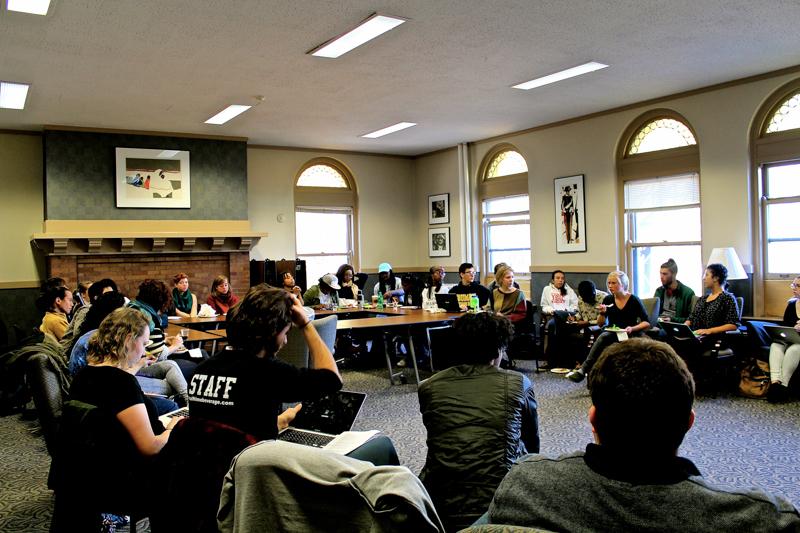Community Calls for More Details in Strategic Plan
Students and faculty members discuss the most recent draft of the Board of Trustees’ Strategic Plan at a listening session on Monday. Students expressed concern over the Strategic Plan’s language, which they called ambiguous and unpromising.
November 20, 2015
Almost all the students at the listening session on Monday had the same overarching question in reaction to the Strategic Plan draft: Where are the specifics?
“This whole document doesn’t say anything; It’s all fluff and clouds,” said Donnay Edmund, College senior. “I didn’t get one concrete thing out of this whole document.”
The Strategic Plan will guide the Board of Trustees’ decision making for the next five to 10 years. The process began at the start of the 2013-14 school year, and the Strategic Planning Steering Committee — a group of trustees, alumni, students, administrators, faculty and staff — plans to submit a final draft in March.
To College senior Andy Thompson, the plan suffers from a lack of concrete goals and a specific timeline for achieving them.
“If it was like: This is what it’s going to look like by this time, I would be much more willing to believe that any of this isn’t a huge waste of time, because at that point we have something we can hold the school accountable to,” Thompson said. “But as long as it has these weak-sauce-ass goals, there’s no way to tell the institution it succeeded or failed. The institution can always say it’s ‘working on it.’”
The draft of the plan discusses “increasing diversity on campus” but offers no specific benchmarks in terms of faculty or student diversity, a fact that left many students wanting.
“The language regarding Oberlin’s goals for diversity is very vague,” said Joshua Koller, Student Senator and College sophomore. “I understand that the plan is just supposed to lay things out in a broad way, but leaving it so vague then allows these things to be just kind of forked out to faculty committees where student representation is even worse than it is on the Steering Committee and not really have student views represented.”
In an email to the Review, Professor of Politics and Steering Committee member Chris Howell wrote that faculty had also raised concerns about the lack of specifics in the plan, especially on diversity.
“My sense of the reaction of those faculty who spoke at the [General Faculty] meeting last week is that several of them found the Strategic Plan vague and lacking in concrete proposals in a number of areas, particularly with regard to its treatment of diversity,” Howell wrote, noting that he was reporting what other faculty members said in the meeting, not his own commentary.
For Edmund, the College should improve diversity by lowering tuition and drawing from underprivileged populations close to home.
“We want 2 percent to 5 percent increase in people of color each year for the next 15 years, and those should come from Lorain, Cleveland, Ohio — Oberlin first,” Edmund said. “And we can’t really do that without having a tuition freeze. … There’s more Black people in Grafton [Correctional Institute] than Oberlin, and that’s never okay.”
While the draft includes language about “slowing the rate of increase in student charges,” many students wanted more specifics about what that would mean. College junior Jeeva Muhil pointed out that the draft does not address living costs, a major financial accessibility issue for many students.
“There’s mention of trying to be more financially accessible in terms of scholarships and tuition, but there’s nothing about living costs, which is a major, major problem for a lot of people who go here. You can get full financial aid in terms of tuition and still have loads of difficult living costs.”
Students also decried the lack of support for students — particularly underrepresented students — and took issue with the Plan’s list of “offices that connect student communities.”
“I have never felt supported by any of these offices, and I don’t think they do much to increase diversity,” said Lisa MacDonald, College senior.
Many students also argued for greater emphasis on the College’s impact on the broader community. College sophomore Aaron Henry said that while the plan mentions integrating students more deeply with the community, it lacks specifics.
“It doesn’t say exactly what’s going to happen,” Henry said. “I want students to have mandatory training to know what area they’re getting into because, if we’re here, we’re four-year temporary citizens of this space, so we need to know what space we’re going into and how we’re affecting it.”
Since the College is a nonprofit and therefore doesn’t pay property taxes, several students said that the institution should make a Payment-in-Lieu-of-Taxes agreement with the city to compensate the city government on a regular basis for the lack of revenue the College provides. To students such as College senior Lila Bhide, the College’s continued expansion in Oberlin makes this issue very pressing.
“I know up until this point Oberlin will do these random acts — they built the new fire station and kind of cover Mercy [Allen Hospital] and a lot of stuff like that — and as much as that makes the College look good, it’s really hard if you’re planning a budget and you have no idea if the College is going to decide to be generous that year,” Bhide said.
MacDonald also pointed out that the draft doesn’t mention the College’s non-administrative staff, such as custodial or dining staff.
“We’ve talked about how the College doesn’t value working-class students. It also doesn’t value the working class that actually works here, and I think that teaches a lot of students to not value those people once they leave our doors.”
President Krislov told the Review in October that the committee will revise the draft based on community feedback and release at least one more draft of the Plan before finalizing it in March.





















